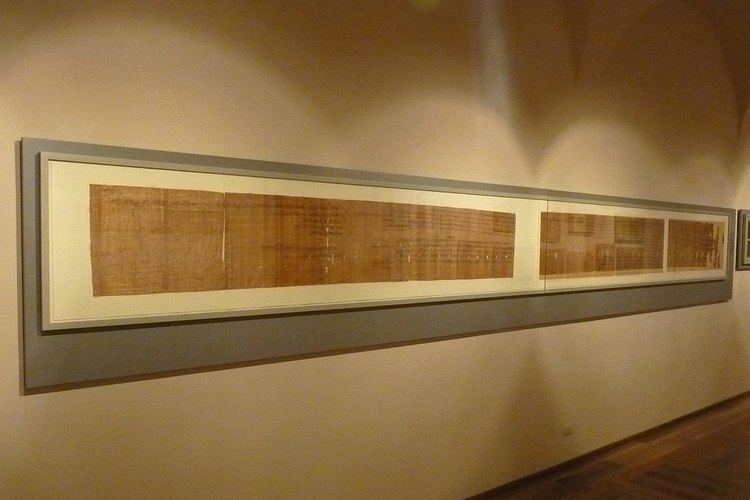 | ||
The Judicial Papyrus of Turin (also Turin legal papyrus) is an ancient Egyptian record of the trials held against conspirators plotting to assassinate Ramesses III in what is referred to as the "harem conspiracy". The papyrus contains mostly summaries of the accusations, convictions and punishments meted out.
Contents
Two further papyri deal with the magical aspects of this case: the Rollin and Lee papyri describe the magic used and the punishments apportioned, which in all three cases was a death sentence.
Historical background
The reign of Ramesses III was characterized by external conflict and internal decline, which seem to have weakened the position of the pharaoh, surrounded by servants and officials of foreign descent. Symptomatic for the state of the country was the apparent incapability of the bureaucracy to supply the workers at Deir el-Medina which brought about the first recorded strike in the history of mankind in the 29th year of Ramesses' reign. In this atmosphere of uncertainty, Queen Tiye wanted to substitute her own son Pentawer for Ramesses' designated heir, Ramesses-Heqamaatre-Meriamun, a son of the main royal wife Ese (Isis), and she had no problems finding influential people who would assist her.
The conspiracy
Tiye enlisted the help of Pebekkamen and a number of important officials serving in close proximity to the king. They obtained magical wax figurines with which they hoped to render the royal guards powerless. The main attack against the king was to come from inside the harem, supported by a revolt on the outside. The plot was uncovered, the conspirators arrested and put on trial.
The trial
The court consisted of twelve judges, among them two overseers of the White House (the ancient Egyptian treasury) and ten further officials of lower rank. In his instructions to the court the king orders them to mete out justice without referring to him. This has been interpreted by some as an attempt on the king's behalf at keeping himself blameless for their fate.
The papyrus is not a detailed record of court proceedings, but rather a list of the defendants–often referring to them by a pseudonym such as Mesedsure, meaning "Re hates him", –the crimes they were accused of and their sentence. The courts actions and decisions were summarized thus:
He was placed before the nobles of the court of examination; they found him guilty; they brought his punishment upon him
In view of the severity of their crimes it is generally assumed that they received the death sentence. The manner of execution is not mentioned. Some of the accused, among them Ramesses' son Pentawer, were allowed (or forced) to take their own lives. The text refers to it laconically:
They (i.e. the judges) left him in his place, he took his own life.
An incident embarrassing to the king occurred during the trial when five of his judges joined six of the accused women in a carousal. One of the judges was condemned to commit suicide, three were disfigured and one reprimanded.
Aftermath
Ramesses died before the records which have survived were written, as in them he is referred to as "the Great God", a term used only for deceased kings at this time. His throat was cut during the plot, as revealed by a CAT scan of his mummy. He was succeeded by his son Ramesses-Heqamaatre-Meriamun, known to us as Ramesses IV.
